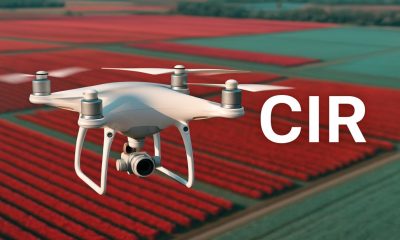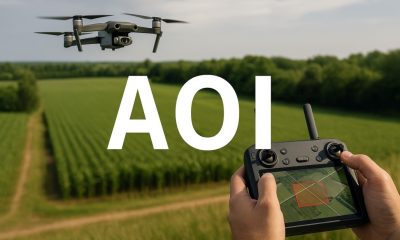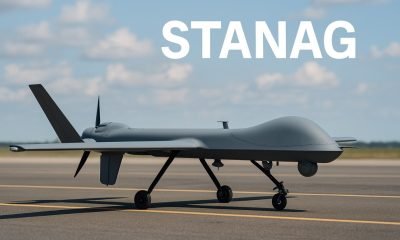- Acronym Guide
- AAM
- ABS
- AC
- ACAS
- ADS-B
- AFAC
- AGL
- AI
- AIM
- ALS
- AM
- AMA
- ANSP
- AOI
- APPI
- AUV
- AUVSI
- ARPAS-UK
- ASTM
- ATC
- BVLOS
- CAA
- CAAC
- CAB
- CASA
- CATT
- CBO
- CBR
- CBRN
- CDMA
- CDR
- CFR
- CIR
- COA
- COMINT
- CORS
- COTP
- COTR
- CPTED
- CV
- C2
- DAA
- DEM
- DFI
- DFS
- DGCA
- DHS
- DOD
- DPA
- DPEs
- DRG
- DRO
- DSM
- DSMX
- DSP
- DSSS
- DTM
- EASA
- EFT
- EO
- EOD
- EO/IR
- ELINT
- EMI
- ESC
- EVLOS
- eVTOLs
- FAA
- FCC
- FCS
- FHSS
- FICCI
- FLIR
- FOB
- FOV
- FPS
- FPV
- GBDAA
- GCP
- GCS
- GDPR
- GML
- GNSS
- GPS
- GSD
- GVC
- HDR
- HOGE
- IACRA
- ICAO
- ICS
- IMU
- INS
- IR
- ISA
- ISR
- ITU
- JARUS
- LAAMS
- LAANC
- LAATM
- LAI
- LBA
- LIDAR
- LOS
- LSALT
- MAC
- MAVLink
- MLIT
- MMS
- MSL
- MTOM
- NDAA
- NCSL
- NFZ
- NIST
- NMEA
- NOTAM
- NPA
- NPRM
- NTIA
- OBIA
- OEM
- OFDM
- OOP
- PASM
- PAV
- PCV
- PdM
- PEC
- PIC
- PID
- PIPL
- PLD
- PM
- PN
- PPK
- PPS
- PSM
- PWM
- UAM
- UAOP
- UAS
- UASTM
- UAV
- UCAVs
- UHD
- UHF
- USV
- UTM
- RAIM
- RCC
- RCS
- RFI
- ReOC
- RePL
- RMS
- ROI
- RPAS
- RPC
- RTH
- RTK
- SaR
- SAR
- SARP
- SBAS
- S.Bus
- SBIR
- SEDENA
- SfM
- SFOC
- SIGINT
- SLAM
- SMS
- SORA
- STANAG
- STTR
- sUAS
- TCAS
- TCCA
- TFR
- TIN
- TOF
- TP
- TPS
- TSA
- VHF
- VLOS
- VTOL
Drone Acronyms
What is SAR (Synthetic Aperture Radar) & How Does it Work?
Published
2 months agoon
By
Jacob StonerTable Of Contents

Definition
Synthetic Aperture Radar (SAR) is a form of active remote sensing that uses radar signals to create high-resolution, two- or three-dimensional images of the Earth’s surface. Unlike optical sensors, SAR systems can penetrate clouds, smoke, and darkness, making them highly effective for imaging in all weather and lighting conditions. On drones, Synthetic Aperture Radar is used for detailed inspections, terrain mapping, disaster response, and infrastructure monitoring.
Usage
Synthetic Aperture Radar is commonly mounted on drones, satellites, and aircraft to monitor surface changes, detect structural shifts, or analyze areas with limited visibility. Drone-based SAR allows for localized, repeated scanning over critical zones such as pipelines, bridges, forests, or disaster zones. The radar pulses emitted by the sensor bounce off the ground or target structures, and the returning signal is processed to form precise images—even from long distances.
Relevance to the Industry
As drones take on more complex inspection and monitoring roles, SAR provides a robust tool for tasks where traditional cameras fall short. In industries like oil and gas, agriculture, construction, and emergency response, SAR-equipped UAVs offer reliable data collection in any environment. SAR is also essential in geospatial analytics, helping to measure ground displacement, monitor landslides, and assess post-disaster conditions.
How Does SAR (Synthetic Aperture Radar) Work?
Synthetic Aperture Radar (SAR) works by emitting microwave radar signals toward the ground and capturing the signals that bounce back. Unlike optical sensors, SAR creates detailed images based on the timing, strength, and phase of the returned signal—making it ideal for all-weather, day-or-night operations. When integrated into drones, SAR enables advanced remote sensing, structural inspection, and terrain mapping from above. Here’s how the system functions:
Signal Transmission
A radar antenna on the drone emits radio frequency pulses toward the Earth’s surface. These pulses travel through the atmosphere and reflect off surfaces such as buildings, vegetation, water, or terrain.
Return Signal Capture
The radar sensor captures the reflected signals (known as backscatter). The time delay and phase shift between emitted and returned signals help determine the distance to the target and its physical properties.
Synthetic Aperture Creation
Unlike traditional radar systems, SAR simulates a large antenna by using the drone’s motion. As the drone moves along a flight path, the radar collects data from multiple angles. These measurements are then stitched together using advanced processing algorithms to create a high-resolution image—as if it had been captured by a much larger radar dish.
Image Processing and Interpretation
SAR data is processed on board or after the flight to form 2D or 3D images. These images can highlight surface features, measure elevation, detect changes in terrain, or reveal objects hidden by foliage or weather obstructions. Processing includes filtering noise, correcting distortions, and applying contrast models to enhance visibility of key features.
Analysis for Monitoring and Detection
SAR allows analysts to:
- Detect small structural shifts or ground movements
- Identify damaged infrastructure
- Track water accumulation or soil saturation
- Assess post-disaster zones quickly—even if cloud cover or smoke is present
- Compare images over time to detect changes and trends
Use in Dynamic Environments
Since SAR isn’t affected by light or weather, it is ideal for emergency scenarios like floods, earthquakes, and landslides. Its ability to capture fine surface variations also makes it valuable for monitoring remote assets like oil pipelines or mountain slopes—especially where sending crews would be unsafe or impractical.
By using motion and radar physics instead of light, Synthetic Aperture Radar transforms drones into precision imaging tools capable of operating under almost any condition.
Example in Use
“After the hurricane, the drone’s Synthetic Aperture Radar (SAR) system mapped flooded terrain and detected shifts in bridge foundations—even through heavy cloud cover.”
Frequently Asked Questions about SAR (Synthetic Aperture Radar)
What makes SAR different from optical imaging?
SAR does not rely on visible light. Instead, it sends out radio waves and measures their reflections. This allows it to “see” through clouds, at night, or in smoky and dusty environments where cameras fail.
Why is SAR useful for drones?
Drones flying lower to the ground can capture high-resolution SAR data over specific targets. This enables regular monitoring of infrastructure or terrain—especially in remote, difficult, or hazardous areas.
Which industries benefit most from drone-mounted SAR?
- Emergency management
- Energy (pipeline and structural inspection)
- Environmental monitoring
- Mining and geological surveying
- Defense and surveillance operations
For examples of these acronyms visit our Industries page.
As the CEO of Flyeye.io, Jacob Stoner spearheads the company's operations with his extensive expertise in the drone industry. He is a licensed commercial drone operator in Canada, where he frequently conducts drone inspections. Jacob is a highly respected figure within his local drone community, where he indulges his passion for videography during his leisure time. Above all, Jacob's keen interest lies in the potential societal impact of drone technology advancements.











